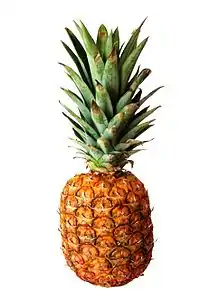Pineapple cake
Pineapple cake (traditional Chinese: 鳳梨酥; simplified Chinese: 凤梨酥; pinyin: fènɡ lí sū; Hokkien: ông-lâi-so͘) is a sweet traditional Taiwanese pastry containing butter, flour, egg, sugar, and pineapple jam or slices.
 Pineapple cake | |
| Alternative names | Fengli Su,[1] pineapple shortcake, pineapple pastry |
|---|---|
| Course | Dessert |
| Place of origin | Taichung |
| Region or state | East Asia |
| Main ingredients | Pastry (butter, egg yolk, sugar), pineapple jam |
History
Pineapple became a critical component of Taiwan's economy during the Japanese era, during which Japanese industrialists imported a wide variety of pineapple cultivars and established numerous processing plants.[2] By the late 1930s, Taiwan had become the third-largest exporter of pineapples in the world.[2] However, when pineapple production in Taiwan shifted toward domestic sales and use of fresh pineapple, local bakeries sought to use this surplus in pastries.[3] While pineapple cakes had historically been produced as a ceremonial food, a combination of governmental promotion and globalization popularized the pineapple cake. Pineapple cakes have become one of the top-selling souvenirs in Taiwan.[4]
Since 2005, the Taipei City Government has run an annual Taipei Pineapple Cake Cultural Festival to foster the growth the local tourism industry and promote sales of the pineapple cake.[5][6] In 2013, the revenue from Taiwan's pineapple cake bakeries totaled NT$40 billion (US$1.2 billion), and sales of pineapple cakes have also bolstered agricultural economies in rural parts of the country.[7][3]
Symbolism
In Hokkien, "pineapple" (王梨; ông-lâi) sounds similar to a phrase meaning "to come forth, prosperous and thriving" (旺來; ōng-lâi).[8] This phrase conveys the hope that many children will be born to the family. As a result, pineapple cakes are often given as engagement gifts, or simply as well-wishing presents in an everyday context. Today pineapple cake is considered a symbol of Taiwan itself.[9]
Varieties
Contemporary pineapple cake bakeries have created variations on the traditional pineapple cake. The filling may also incorporate preserved egg yolks or other dried fruits such as cranberries or strawberries.[10]
Bakeries may also add winter melon to the pineapple jam. This practice was initially an effort to make the tart pineapple filling more palatable. However, in contemporary bakeries, adding winter melon to the filling may be seen as an indicator of lower quality.[7]
The annual Taipei Pineapple Cake Cultural Festival often features a contest in which bakeries compete to create pineapple cakes that incorporate unconventional ingredients, such as rice or Taiwanese tea.[5][6]
References
- Schwankert, Steven (January 17, 2015). "Before and After (Taiwanese): Beyond Taipei's Night Market Snacks". The Beijinger. Retrieved January 13, 2016.
- (Taiwan), Ministry of Foreign Affairs, Republic of China (1960-11-01). "Taiwan's Growing Pineapple Industry - Taiwan Today". Taiwan Today. Retrieved 2017-07-22.
- "Pineapple cakes boost Taiwan's rural industries". www.fftc.agnet.org. Archived from the original on 2019-01-08. Retrieved 2017-07-22.
- "The Who's Who of Taiwan's Pineapple Cake Industry". City543. Retrieved 2017-07-22.
- 黃紫緹 (2014-07-04). "Pineapple Cake Festival to Take Place Next Weekend". tcgwww.taipei.gov.tw. Retrieved 2017-07-22.
- 黃紫緹 (2011-08-18). "Pineapple Cake Fiesta Kicks off in Taipei". english.gov.taipei. Retrieved 2017-07-22.
- "The Pineapple Cake Chronicles - Taiwan Business TOPICS". Taiwan Business TOPICS. 2016-01-29. Retrieved 2017-07-22.
- "Entry #1270 (王梨)". 臺灣閩南語常用詞辭典 [Dictionary of Frequently-Used Taiwan Minnan]. (in Chinese and Hokkien). Ministry of Education, R.O.C. 2011.
- Hiufu Wong, Maggie. "40 of the best Taiwanese foods and drinks". edition.cnn.com. CNN. Retrieved 8 April 2020.
- "Pineapple cake festival opens in Taipei - Taipei Times". www.taipeitimes.com. Retrieved 2017-07-22.
External links
 Media related to Pineapple cakes at Wikimedia Commons
Media related to Pineapple cakes at Wikimedia Commons

